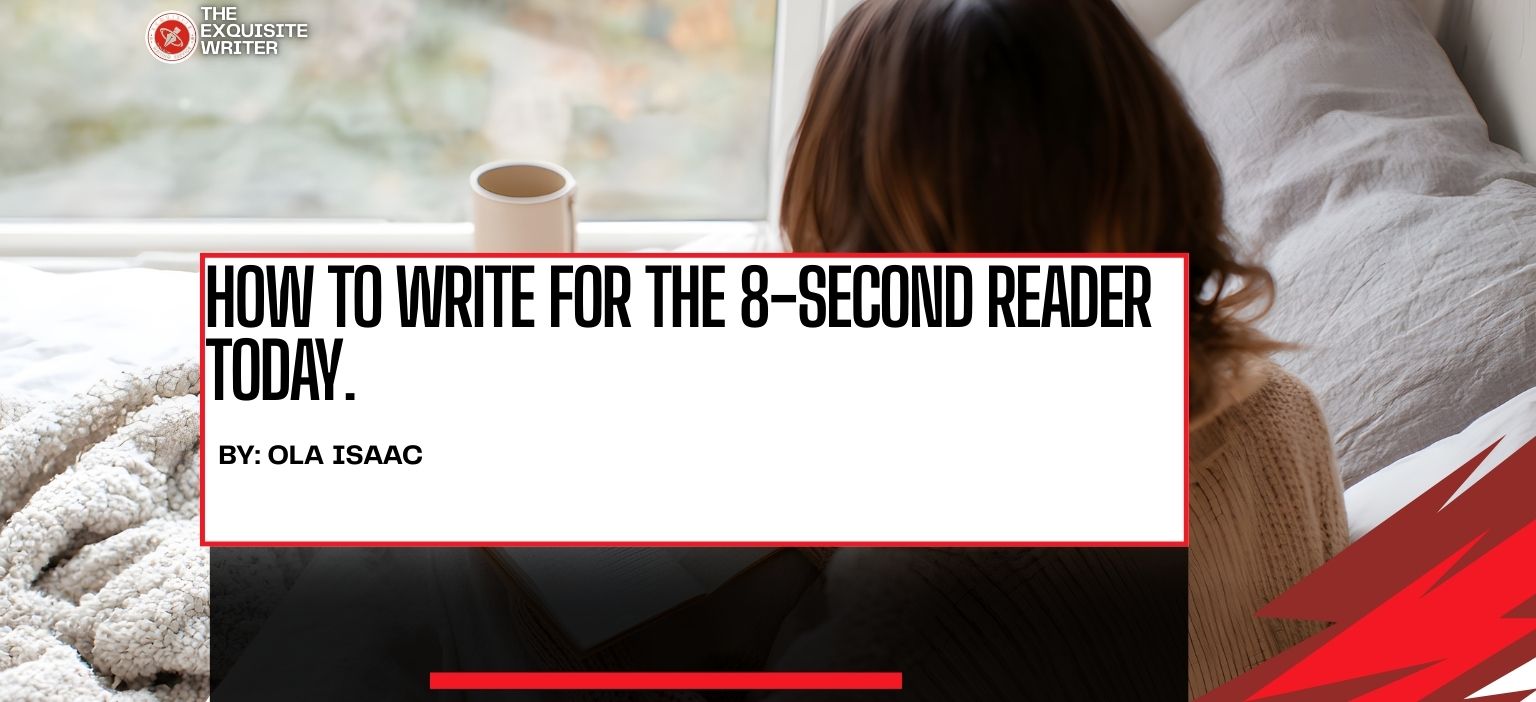We live in an era where attention is the most valuable currency online, and writers strive for it really hard!
Research shows that people often switch tasks or lose focus quickly when online, not because their attention spans are shorter, but because digital environments are highly distracting.
That means your audience is scrolling quickly, consuming content faster, and dropping anything that doesn’t immediately grab their attention. Well, we won’t blame them.
For businesses, this reality is both a challenge and an opportunity.
If you can hook readers instantly, you win their engagement, trust, and eventually their business. If you can’t, they’ll keep scrolling, right to your competitor.
So how do you write for the 8-second reader? Here’s your playbook—simple and sweet!

How You Can Write for the 8-Second Reader
Here are invaluable tips you can bank on:
1. Start With a Punch, Not a Warm-Up
Your opening line is like the headline of a movie trailer: it must grab attention instantly, or the audience will walk out.
On the internet, people aren’t patient. They’re skimming, swiping, and juggling ten tabs at once.
What does that mean? That means you can’t waste time with throat-clearing intros.
Most content fails in the first few lines because it eases in too gently.
Readers don’t want to wade through background context or generic setups—they want a reason to care right now.
A bold statement, shocking stat, or relatable pain point does the job.
So, here are quick and smooth ways to get things done:
- Instead of this lukewarm opener: “In today’s digital landscape, attention spans are shrinking and businesses must adapt to survive.”
That line could belong to any article on the internet—it doesn’t make your piece stand out, and we won’t advise you to take that route.
- So try this instead: “Eight seconds. That’s all you get before a reader decides if you’re worth their time or if they’re bouncing to your competitor.”
Did you notice the difference? The first is flat and predictable. The second puts the reader on the clock.
Suddenly, the pressure is real, and the stakes are clear.
Here are a few more punchy alternatives you could use to open different types of content:
- Bold claim: “Your blog isn’t failing because of SEO, it’s failing because your opening line is boring.”
- Surprising stat: “70% of people never scroll past your first paragraph. That means your intro is either your biggest asset or your biggest liability.”
- Relatable pain point: “Ever clicked on an article, skimmed the intro, and thought, ‘Ugh, not another one of these’?
That’s precisely what your readers think too!” So, just make sure you are standing out!
When you lead with this kind of energy, you don’t just capture attention. Instead, you earn permission to keep talking.
The rest of your content becomes easier to digest because you’ve proven, right from the start, that you value the reader’s time.
Related Read: The Art of Freewriting: Let Ideas Flow Without Fear
2. Embrace Micro-Content Thinking
Scroll through TikTok, Instagram Reels, or YouTube Shorts, and you’ll notice something: nobody waits around for context.
If a video doesn’t grab you in the first few seconds, you swipe to the next.
That’s the essence of micro-content thinking—content designed to be snackable, punchy, and self-contained.
Even if you’re creating long-form blogs, case studies, or web copy, the same principle applies.
Your audience may intend to read more, but they’ll only commit if every small piece of your content feels worth their time.
Here’s how to apply micro-content thinking to your writing:
- Break content into bite-sized sections: Huge walls of text feel overwhelming.
Short paragraphs and plenty of white space make your content skimmable. Think of it like giving your reader breathing room.
- Use subheadings that double as hooks: Don’t just label sections with bland headers like “Our Services.”
Instead, use them to spark curiosity or highlight value. For Example: “How We Turn Browsers Into Buyers.”
- Make every sentence earn its spot: Just pretend you’re editing a script for a 15-second TikTok.
If a sentence doesn’t move the story forward or add value, cut it. Fluff kills attention faster than bad grammar, and I can bet it with you, it’s true!
- Think in mini-stories rather than essays: Instead of lengthy explanations, share concise stories or examples.
A quick customer win, a stat paired with a takeaway, or a relatable analogy can do more than three dense paragraphs of explanation.
For example, instead of writing, “Social media has become an important tool for businesses to connect with their audiences and promote their products or services in a cost-effective way,”
Try: “One viral TikTok can do more for your brand than a year of cold emails.”
See the difference? One is academic and long-winded. The other is sharp, visual, and built for today’s skimmer.
The beauty of micro-content thinking is this:
When you build long-form content out of bite-sized, engaging nuggets, you’re not just writing an article; you’re creating dozens of standalone takeaways that can be repurposed into tweets, LinkedIn posts, captions, or scripts for short-form videos.
That’s how you win in an attention-short world: write less like a lecturer and more like a storyteller with a stack of quick punches.
3. Front-Load Value
Imagine walking into a restaurant, ordering food, and the waiter says, “Sure, but we’ll serve the appetizer in 40 minutes, and the main dish after an hour.”
Would you stay? Probably not! That’s precisely what happens when you hide your best insights deep in your content. It causes readers to leave before the value is revealed.
In the age of short attention spans, your audience wants the gold upfront.
Don’t make them dig. When you lead with your most important takeaway, you:
- Instantly prove your expertise.
- Build trust that you won’t waste their time.
- Increase the odds they’ll keep reading for the details.
For example, instead of spending three paragraphs setting up the idea that “email subject lines with numbers get higher opens,” just say it immediately:
- “Subject lines with numbers boost open rates by up to 45%. Want proof? Let’s look at real examples.”
That way, the reader gets value in seconds, and you earn their attention for the breakdown that follows.
Here are a few strategies to front-load value effectively:
- Lead with the “what,” then unpack the “why” and “how.”
Example: “Stories in ads boost brand recall by 22%. Here’s why and how to use that insight in your next campaign.”
- Use the inverted pyramid style: Journalists have mastered this approach. The most essential facts are presented at the top, followed by supporting details, and then background information. It’s reader-first writing.
- Hook with results before the process: Instead of starting with “We tested five strategies over three months,” open with, “We doubled organic traffic in 90 days—here’s the exact process.” The result earns the right to explain the process.
- Think of it like a movie trailer: the best trailers show the highlights right away, not 90 minutes in.
Your content should provide readers with a highlight reel first, then deliver the full experience to those who stick around.
The bottom line? Respect your reader’s time. If you front-load value, they’ll reward you by scrolling, clicking, and even sharing—because you’ve proven you’re worth it.
4. Write Like You Talk
The 8-second reader isn’t impressed by corporate jargon or MBA buzzwords.
They’re not looking for a dissertation.
In actual words, they are scanning for connection, clarity, and quick wins.
If your writing feels like a lecture, they’ll tune out.
Instead, strip your language down to what you’d actually say in a conversation.
Think of how you’d explain it to a friend over coffee.
That’s the tone your audience craves: real, human, and relatable.
Here’s why this works:
- Clarity beats complexity. If people need a dictionary to understand you, they’ll stop reading.
- Short sentences punch harder. Long, winding explanations lose readers. Keep it crisp.
- Conversational tone builds trust. People buy from brands that sound human, not robotic.
Example comparison: “Implementing cross-platform engagement strategies is imperative to optimize customer acquisition funnels.”
“Want more customers? Be everywhere they hang out.”
Do you see the difference? One sounds like a corporate memo. The other feels like advice from a wise friend.
Another example:
- “Our innovative solutions synergize data-driven methodologies with cutting-edge technology.”
- “We use smart tools to help you work faster and better.”
- When in doubt, read your writing out loud.
If it sounds stiff or unnatural, rewrite it until it feels like a conversation. The 8-second reader will thank you by sticking around.
5. Visuals Are Part of the Writing
In the digital age, writing isn’t just about words.
It’s about how those words look on the page. A block of text feels like homework. Visual breaks, on the other hand, invite readers to keep scrolling.
Think of visuals as part of your writing toolkit:
- Bullet points (like this ????) make lists digestible.
- Bold or italic highlights key ideas so they stand out.
- Subheadings break articles into snackable sections.
- Images, infographics, or GIFs add energy and variety.
- Pull-quotes spotlight memorable lines and keep eyes moving down the page.
- Even small tweaks can change how readers interact. For example:
A dense paragraph:
“Effective communication requires the ability to simplify complex ideas, and writers must consider formatting, structure, and the inclusion of visuals in order to keep readers engaged throughout the content.”
A reader-friendly version:
Excellent writing isn’t just about words. It’s about how those words look:
- Short paragraphs.
- Clear structure.
- Visual breaks that keep readers engaged.
Which one are you more likely to read to the end? Exactly.
Every time you add a bullet list, drop in a graphic, or bold a key phrase, you’re buying yourself another few seconds of attention.
And in today’s world, a few seconds can mean the difference between a bounce and a conversion.
6. End With a Next Step
An 8-second reader may not stay long. However, if you hook them, you can guide them to take action. Always close with a CTA (call-to-action):
- Read more.
- Download a guide.
- Book a call.
- Don’t just inform—direct.
Next Article: 16 Writing Skills Examples to Level Up Your Craft
Final Takeaway
The short attention span era doesn’t mean long-form content is dead.
It means long-form must act like short-form inside.
It must be structured for skimmers, written for scrollers, and optimized for speed.
Write with clarity, punch, and flow, and your business won’t just survive in the 8-second world; you’ll thrive in it.
If you want readers to stay, don’t wait for them to find the value, deliver it instantly, sentence by sentence.
Start applying these tips today and watch your engagement rise.

